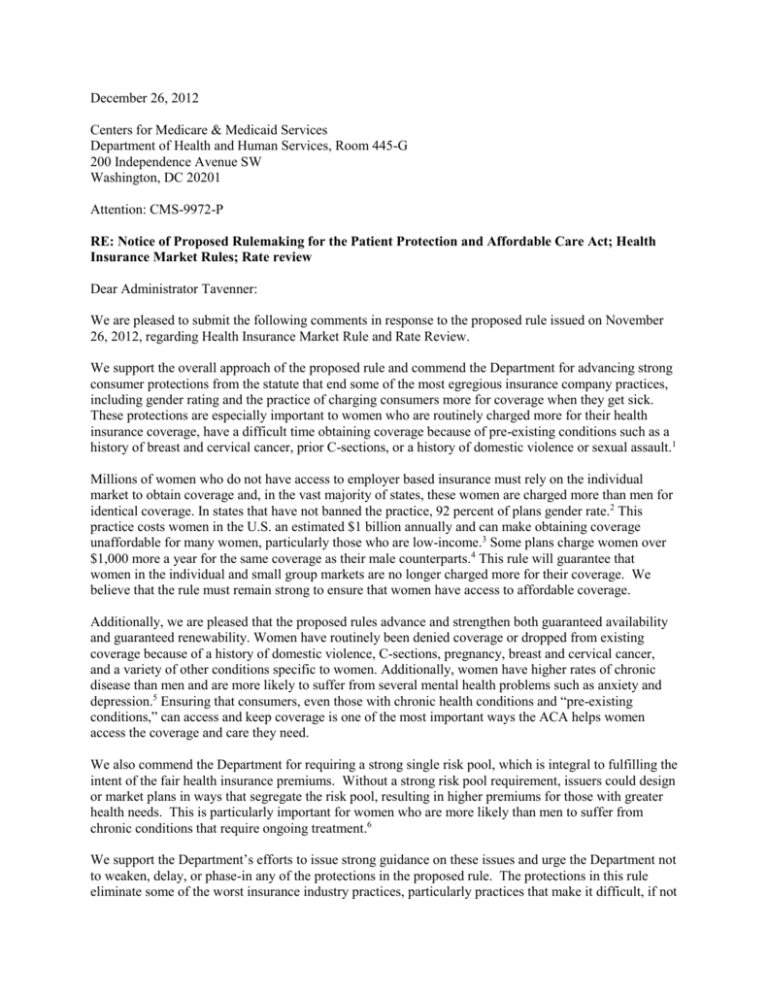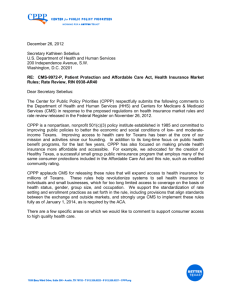December 26, 2012 Centers for Medicare & Medicaid Services
advertisement

December 26, 2012 Centers for Medicare & Medicaid Services Department of Health and Human Services, Room 445-G 200 Independence Avenue SW Washington, DC 20201 Attention: CMS-9972-P RE: Notice of Proposed Rulemaking for the Patient Protection and Affordable Care Act; Health Insurance Market Rules; Rate review Dear Administrator Tavenner: We are pleased to submit the following comments in response to the proposed rule issued on November 26, 2012, regarding Health Insurance Market Rule and Rate Review. We support the overall approach of the proposed rule and commend the Department for advancing strong consumer protections from the statute that end some of the most egregious insurance company practices, including gender rating and the practice of charging consumers more for coverage when they get sick. These protections are especially important to women who are routinely charged more for their health insurance coverage, have a difficult time obtaining coverage because of pre-existing conditions such as a history of breast and cervical cancer, prior C-sections, or a history of domestic violence or sexual assault.1 Millions of women who do not have access to employer based insurance must rely on the individual market to obtain coverage and, in the vast majority of states, these women are charged more than men for identical coverage. In states that have not banned the practice, 92 percent of plans gender rate.2 This practice costs women in the U.S. an estimated $1 billion annually and can make obtaining coverage unaffordable for many women, particularly those who are low-income.3 Some plans charge women over $1,000 more a year for the same coverage as their male counterparts.4 This rule will guarantee that women in the individual and small group markets are no longer charged more for their coverage. We believe that the rule must remain strong to ensure that women have access to affordable coverage. Additionally, we are pleased that the proposed rules advance and strengthen both guaranteed availability and guaranteed renewability. Women have routinely been denied coverage or dropped from existing coverage because of a history of domestic violence, C-sections, pregnancy, breast and cervical cancer, and a variety of other conditions specific to women. Additionally, women have higher rates of chronic disease than men and are more likely to suffer from several mental health problems such as anxiety and depression.5 Ensuring that consumers, even those with chronic health conditions and “pre-existing conditions,” can access and keep coverage is one of the most important ways the ACA helps women access the coverage and care they need. We also commend the Department for requiring a strong single risk pool, which is integral to fulfilling the intent of the fair health insurance premiums. Without a strong risk pool requirement, issuers could design or market plans in ways that segregate the risk pool, resulting in higher premiums for those with greater health needs. This is particularly important for women who are more likely than men to suffer from chronic conditions that require ongoing treatment.6 We support the Department’s efforts to issue strong guidance on these issues and urge the Department not to weaken, delay, or phase-in any of the protections in the proposed rule. The protections in this rule eliminate some of the worst insurance industry practices, particularly practices that make it difficult, if not impossible, for women to obtain affordable health coverage. The rule must remain strong and take effect in 2014, as required by the law, to ensure women are not denied coverage or charged more simply because they are women. § 144.102 Scope and Applicability § 144.102(c) Association plans are considered coverage in the individual market We support the clarification that association coverage that is not associated with employment “is considered coverage in the individual market.”7 There is nothing in the ACA suggesting association plans are to be regulated as anything other than coverage in the individual market. Regulating association plans as coverage in the individual market, as well as requiring association plans to follow the same requirements as other plans in the individual market, is necessary to ensure women are protected from gender rating and coverage denials for pre-existing conditions. Any lesser regulation of association plans would create gaps in the ACA in which association plans could be created to circumvent the important protections in this proposed rule. We thank the Department for the clarification and recommend that to further eliminate ambiguity, the Department strike the word “considered” from the final regulation to read: “The coverage is considered coverage in the individual market, regardless of whether it is considered group coverage under state law.” This change will clarify that association coverage is no different than other coverage in the individual market for purposes of the ACA. § 147.102 Fair Health Insurance Premiums As noted above, this proposed rule will protect consumers from some of the most egregious insurance company practices, including the practice of gender rating and charging consumers more for coverage when they get sick.8 We strongly urge the Department not to weaken any portion of § 147.102. We wish to provide feedback on some of the specific proposals that will ensure women and all consumers will have access to fair health insurance premiums. § 147.102(a)(1)(iii) Enrollee’s age as of date of policy issuance or renewal The statute limits the amount that a health insurance issuer may vary rating based on age to a ratio of 3 to 1.9 We support the proposed rule’s approach to implementing these limits, including the requirement that issuers who practice age rating must use the enrollee’s age as of the date of policy issuance or renewal to calculate this variation. This policy will provide a simple, transparent rating process. It will also ensure that consumers pay a consistent price for their coverage throughout the year, rather than experience a rate increase on each enrollee’s birthday. For families, allowing mid-year rate increases could cause significant confusion as rates could change multiple times corresponding to each family member’s birthday. Mid-year rate increases would also add complexity to the administration of the advance payment of the premium tax credits. We recommend the Department finalize the proposed rule that, when an issuer varies the rate by age, the enrollee’s age as of the date of policy issuance or renewal is used in determining an age adjustment for the entire plan year. § 147.102(d) and § 147.102(e) Uniform age bands and age rating curves We commend the Department for proposing strong regulations that standardize age rating across the individual and small group markets, and require use of a standard age curve. The use of a single child age band for children aged 0-20, as proposed in § 147.102(d)(1), will provide simplicity for families looking into the cost of coverage and will prevent issuers from charging higher premiums for infants because of the cost of newborn care. The use of one year age bands for adults, as proposed in § 147.102(d)(2), along with uniform age rating curves proposed in § 147.102(e), will create a gradual increase in premiums with age, preventing large spikes in premiums when enrollees achieve certain ages. § 147.104 Guaranteed Availability of Coverage We reiterate our earlier comments about the importance of guaranteed availability of coverage for women. These regulations will prevent women from being denied coverage because of pre-existing conditions such a history of domestic violence, C-sections, pregnancy, breast and cervical cancer, and a variety of other conditions specific to women. We urge the Department not to weaken any of the guaranteed availability requirements as drafted in the proposed regulation and further suggest strengthening protections through special enrollment periods and marketing as described below. § 147.104(b)(2) Special enrollment periods Special enrollment periods are important to women due to the many instances where women experience a change in life circumstances, including pregnancy. Special enrollment periods should ensure that women do not experience gaps in insurance coverage during a transition, and that they can choose a coverage level that best suits their needs. Given the importance of special enrollment periods, the Department should expand the rule’s special enrollment requirements to scenarios where changes in life circumstances warrant a change in coverage. We recommend that all qualifying events for special enrollment periods required inside of exchanges apply to the individual and small group markets outside of an exchange. For women in particular, pregnancy should trigger a special enrollment period, enabling women to choose an appropriate coverage option. For example, if a woman holds coverage through a catastrophic plan that has a high deductible that applies to maternity services, she should have the option to change her coverage tier. Because qualified individuals become eligible for a special enrollment period if he or she gains a dependent through “marriage, birth, adoption or placement for adoption” we encourage the Department apply this provision to civil unions or registered domestic partners as defined by particular state laws. § 147.104(e) Marketing Marketing rules that prohibit discriminatory practices are critical to ensuring that issuers do not attempt to steer older, sicker individuals away from certain plans while trying to attract younger, healthier individuals. If plans outside the exchange market less comprehensive coverage to younger, healthier individuals, then those individuals will gravitate toward plans outside the exchange. The likely result would be higher premiums for plans offered in the exchange, thus undermining its capacity to offer affordable coverage. Strong federal standards must moderate marketing practices and mitigate the risk of adverse selection. This issue is especially important for women who are more likely than men to manage multiple chronic conditions and have less access to affordable health coverage. For these reasons, we strongly support a marketing standard that applies uniform standards inside and outside the exchanges. However, the standards in § 147.104(e) must be expanded to incorporate all applicable nondiscrimination protections. Section 147.104(e) of the proposed rule prohibits a health insurance issuer and its officials, employees, agents, and representatives from employing “marketing practices or benefit designs that will have the effect of discouraging enrollment of individuals with significant health needs in insurance coverage.”10 This is incomplete and thus inadequate. The final QHP and Exchange rule expressly state the full range of applicable nondiscrimination protections.11 This rule should also specifically enumerate these protections so that there is no confusion about the uniform standard that applies inside and outside the exchanges. 12 Section 147.104 should therefore explicitly prohibit issuers from employing marketing practices and benefit designs that discriminate on the bases included in the Exchange and QHP regulations and pursuant to § 1557.13 § 147.106 Guaranteed Renewability of Coverage We support the Department’s efforts in the proposed rule to advance the issue of guaranteed renewability—an important consumer protection which ensures that all individuals, even those with chronic health conditions and pre-existing conditions, can keep their coverage. This protection is critical for women given that they have higher rates of chronic disease than men and are more likely to suffer from mental health problems. In the current market, women are routinely been denied coverage or dropped from existing coverage due to pre-exiting conditions or health issues. We urge the Department not to weaken any of the guaranteed renewability requirements included in the proposed regulation and further suggest strengthening this protection through broader exceptions for nonpayment of premiums and movement outside of the service area as described below. § 147.106(b)(1)Nonpayment of Premiums We are concerned that the exception for nonpayment of premiums could result in enrollees losing their health insurance coverage because of small, insignificant errors in payments. The final rule should include a provision requiring health insurance issuers offering coverage in the individual market and small group markets to renew or continue in force the coverage if the plan sponsor or individual has failed to pay an insignificant portion of the contribution or premium. There is precedent for an insignificant underpayment provision in COBRA regulations. A similar provision should be included in § 147.106(b)(1) so that the exception for nonpayment of premiums does not apply if the nonpayment is insignificant. For the individual market, we recommend the Department adopt the definition of insignificant underpayment in the COBRA regulations, which is the lesser of $50 or 10 percent of the premium.14 We recognize that there may need to be a different standard for the small group market and urge the Department to define insignificant underpayment for this market. § 147.106(b)(5) Enrollees’ movement outside service area The final regulation should provide limitations and caveats on an issuer’s ability to determine whether an enrollee no longer lives, resides, or works in the service area of the issuer. Under the Medicare Advantage regulations, an individual is only considered to have moved outside the service area if the individual has permanently moved outside the MA plan’s service area or has left the service area continuously for more than 6 months.15 We recommend that the following language be added to the end of § 147.106(b)(5): An enrollee is considered to live, reside or work in the service area of the issuer unless the enrollee has permanently moved outside of the MA plan’s service area at the time of reenrollment or has been out of the plan service area continuously for more than 6 months at the time the renewability decision is made and will not be returning to the service area prior to the new benefit year. § 150.103 Definitions As noted previously in these comments, we support the inclusion of a policy “[i]ssued to an association that makes coverage available to individuals other than in connection with one or more group health plans” within the definition of “individual health insurance policy.”16 § 156.155 Enrollment in Catastrophic Plans § 156.155(b) Coverage of preventive health services We commend the Secretary for clarifying in § 156.155(b) that catastrophic plans must include the preventive health services in § 2713 of the Public Health Service (PHS) Act, as added by § 1001 of the ACA. This clarification ensures that important preventive health services like well-woman visits, mammograms, and contraception will be included in catastrophic plans with no cost sharing. While we appreciate Department’s inclusion of the preventive services in § 2713 within catastrophic plans, we reiterate the importance of issuing sub-regulatory guidance to ensure the preventive services provision is fully implemented in compliance with the ACA’s intent. We reiterate our appreciation of the Department’s work to implement the ACA, including these proposed rules that will create strong consumer protections in the insurance market. These protections will eliminate some of the worst insurance industry practices including gender rating, rescission of coverage, and denial of coverage due to pre-existing conditions. We urge the Department not to weaken, delay, or phase-in any of the protections in the proposed rule. The rule must remain strong and take effect in 2014, as required by the law, to ensure women are no longer treated as “pre-existing conditions.” There have already been impressive strides made in expanding health care for women under the Affordable Care Act. These proposed rules make great strides in ending insurance practices that deny necessary care to women. We thank you for this chance to provide input on this important provision. Sincerely, 1 Most states have recognized that a history of domestic violence is not a pre-existing condition and have banned insurance companies from rating based on a history of domestic violence. However, several states still allow insurers to deny health coverage to domestic violence survivors, and many more have inadequate domestic violence insurance discrimination protections. See Brigette Courtot & Julia Kaye, Nat’l Women’s Law Ctr., Still Nowhere To Turn: Insurance Companies Treat Women Like a Pre-Existing Condition 6 (2009), available at http://www.nwlc.org/sites/default/files/pdfs/stillnowheretoturn.pdf. The ACA’s ban on rating based on pre-existing conditions preempts any state law that currently allows this practice. Patient Protection and Affordable Care Act, Pub. L. No. 111-148, § 1201 (2010), as amended by the Health Care and Education Reconciliation Act of 2010, Pub. L. No. 111-152, 124 Stat. 1029 (2010) (to be codified at 42 U.S.C. 300gg-3) (prohibiting preexisting condition exclusions and other discrimination based on health status); Health Insurance Market Rules; Rate Review, 77 Fed. Reg. 70584 (proposed Nov. 26, 2012). 2 Danielle Garrett, Nat’l Women’s Law Ctr., Turning to Fairness: Insurance Discrimination Against Women Today and the Affordable Care Act 7 (March 2012) available at http://www.nwlc.org/sites/default/files/pdfs/nwlc_2012_turningtofairness_report.pdf 3 Id. 4 Id. at 4. 5 Elizabeth M. Patchias & Judy Waxman, The Commonwealth Fund and The National Women’s Law Center, Women and Health Coverage: The Affordability Gap 4 (Apr. 2007), available at http://www.commonwealthfund.org/usr_doc/1020_Patchias_women_hlt_coverage_affordability_gap.pdf 6 Id. 7 Health Insurance and Market Rules; Rate Review, 77 Fed. Reg. 70,584, 70,6011 (proposed Nov. 26, 2012). 8 In addition to the express prohibition on gender rating in the individual and small group markets, we note that § 1557 of the Affordable Care Act also prohibits this practice. Patient Protection and Affordable Care Act, Pub. L. No. 111-148, § 1557 (2010), amended by Health Care and Education Affordability and Reconciliation Act, Pub. L. No. 111-152 (2010) (to be codified at 42 U.S.C. § 18116). 9 Patient Protection and Affordable Care Act, Pub. L. No. 111-148, § 2711(a)(1)(A)(iii) (2010), amended by Health Care and Education Affordability and Reconciliation Act, Pub. L. No. 111-152 (2010) (to be codified at 42 U.S.C. § 300gg). 10 Health Insurance and Market Rules; Rate Review, 77 Fed. Reg. 70584, 70613 (proposed Nov. 26, 2012) (to be codified at 45 C.F.R. 147.104(e)). 11 45 C.F.R § 155.120(c)(2) (2012) (requiring that, “in carrying out the requirements of this part, the State and the Exchange must: [n]ot discriminate based on race, color, national origin, disability, age, sex, gender identity or sexual orientation.”) The final rule clarifies that this standard applies to “all activities of the Exchange” including “marketing, outreach , and enrollment.” Establishment of Exchanges and Qualified Health Plans; Exchange Standard for Employers, 77 Fed. Reg. 18,310, 18,319 (Mar. 27, 2012). 12 See Health Insurance and Market Rules; Rate Review, 77 Fed. Reg. 70,584, 70,598 (proposed Nov. 26, 2012) (stating that applying one standard to the insurance marketplace aims to “ensure consistency in the marketing of plans inside and outside of the Exchanges”). 13 45 C.F.R § 155.120(c)(2) (2012) (prohibiting the State and the exchange from discriminating); 45 C.F.R. § 156.200(e) (2012) (prohibiting QHP issuers from discriminating based on race, color, national origin, sex, age, disability, gender identity, or sexual orientation); Patient Protection and Affordable Care Act, Pub. L. No. 111-148, § 1557 (2010), amended by Health Care and Education Affordability and Reconciliation Act, Pub. L. No. 111-152 (2010) (to be codified at 42 U.S.C. § 18116) (prohibits discrimination on the basis of race, color, national origin, sex, age, and disability in health programs or activities that receive federal financial assistance, are administered by an Executive agency, or were established by Title I of the ACA). 14 26 C.F.R. Part§ 54.4980B 8(d)(2012) 15 42 C.F.R. § 422.74(d)(4)(ii) (2012). 16 Health Insurance and Market Rules; Rate Review, 77 Fed. Reg. 70,584, 70,614 (proposed Nov. 26, 2012) (to be codified at 45 C.F.R. § 150.103(1)).






